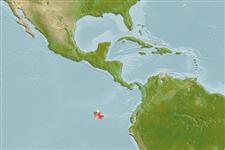Environment: milieu / climate zone / depth range / distribution range
Écologie
marin récifal; profondeur 0 - 10 m (Ref. 57883). Tropical
Southeast Pacific: Galapagos Islands.
Taille / Poids / Âge
Maturity: Lm ? range ? - ? cm
Max length : 7.0 cm TL mâle / non sexé; (Ref. 11482)
Rayons mous dorsaux (Total): 68-80; Rayons mous anaux: 51 - 59; Vertèbres: 39 - 43. This species is characterized by the following: vertebrae 11-12 + 27-31 = 39-43, dorsal fin rays 68-80, anal fin rays 51-59; outer pseudoclasper with a broad base and long supporter with sharp, pointed tip; inner pseudoclasper is anteriorly inclined, of about length of outer pseudoclasper, with sharp, spine-like tip anteriorly and fleshy flap posteriorly; isthmus between pseudoclaspers wide, penis with abrupt change in thickness; opercular spine with a single, sharp tip; cheeks naked or with few isolated scales (less than 10 scales all together); otolith length: height ratio 2.1-2.2; upper preopercular pore absent (Ref. 57883).
Inhabits rocky crevices (Ref. 11482). Two paratypes that were collected at low tide between blocks of lava in about 50 cm of water, were observed to move slowly close to the sand bottom. Experiments that were carried out showed that O. deroyi can tolerate a wide
variation in salinity, but not the low salinity in which O. galapagosensis lives. Consequently, there is an ecological barrier separating the two species. Only about five embryos were observed in ripe females (Ref. 57883).
Life cycle and mating behavior
Maturité | Reproduction | Frai | Œufs | Fécondité | Larves
Møller, P.R., W. Schwarzhans and J.G. Nielsen, 2005. Review of the American Dinematichthyini (Teleostei: Bythitidae). Part II. Ogilbia. aqua, J. Ichthyol. Aquat. Biol. 10(4):133-207. (Ref. 57883)
Statut dans la liste rouge de l'IUCN (Ref. 130435)
Menace pour l'homme
Harmless
Utilisations par l'homme
Pêcheries: sans intérêt
Plus d'informations
PaysZones FAOÉcosystèmesOccurrencesIntroductionsStocksÉcologieRégime alimentaireÉléments du régime alimentaireConsommation alimentaireRation
Noms communsSynonymesMétabolismePrédateursÉcotoxicologieReproductionMaturitéFraiRassemblement de ponteFéconditéŒufsDéveloppement de l'œuf
RéférencesAquacultureProfil d'aquacultureSouchesGénétiqueElectrophoresesHéritabilitéPathologiesTraitementNutrientsMass conversion
CollaborateursImagesStamps, Coins Misc.SonsCiguateraVitesseType de nageSurface branchialeOtolithesCerveauxVision
Outils
Articles particuliers
Télécharger en XML
Sources Internet
Estimates based on models
Preferred temperature (Ref.
123201): 23.6 - 24.6, mean 23.9 °C (based on 12 cells).
Phylogenetic diversity index (Ref.
82804): PD
50 = 0.5000 [Uniqueness, from 0.5 = low to 2.0 = high].
Bayesian length-weight: a=0.00389 (0.00180 - 0.00842), b=3.12 (2.94 - 3.30), in cm total length, based on all LWR estimates for this body shape (Ref.
93245).
Niveau trophique (Ref.
69278): 3.3 ±0.5 se; based on size and trophs of closest relatives
Résilience (Ref.
120179): Faible, temps minimum de doublement de population : 4,5 à 14 années (Assuming Fec < 100).
Fishing Vulnerability (Ref.
59153): Low vulnerability (10 of 100).
